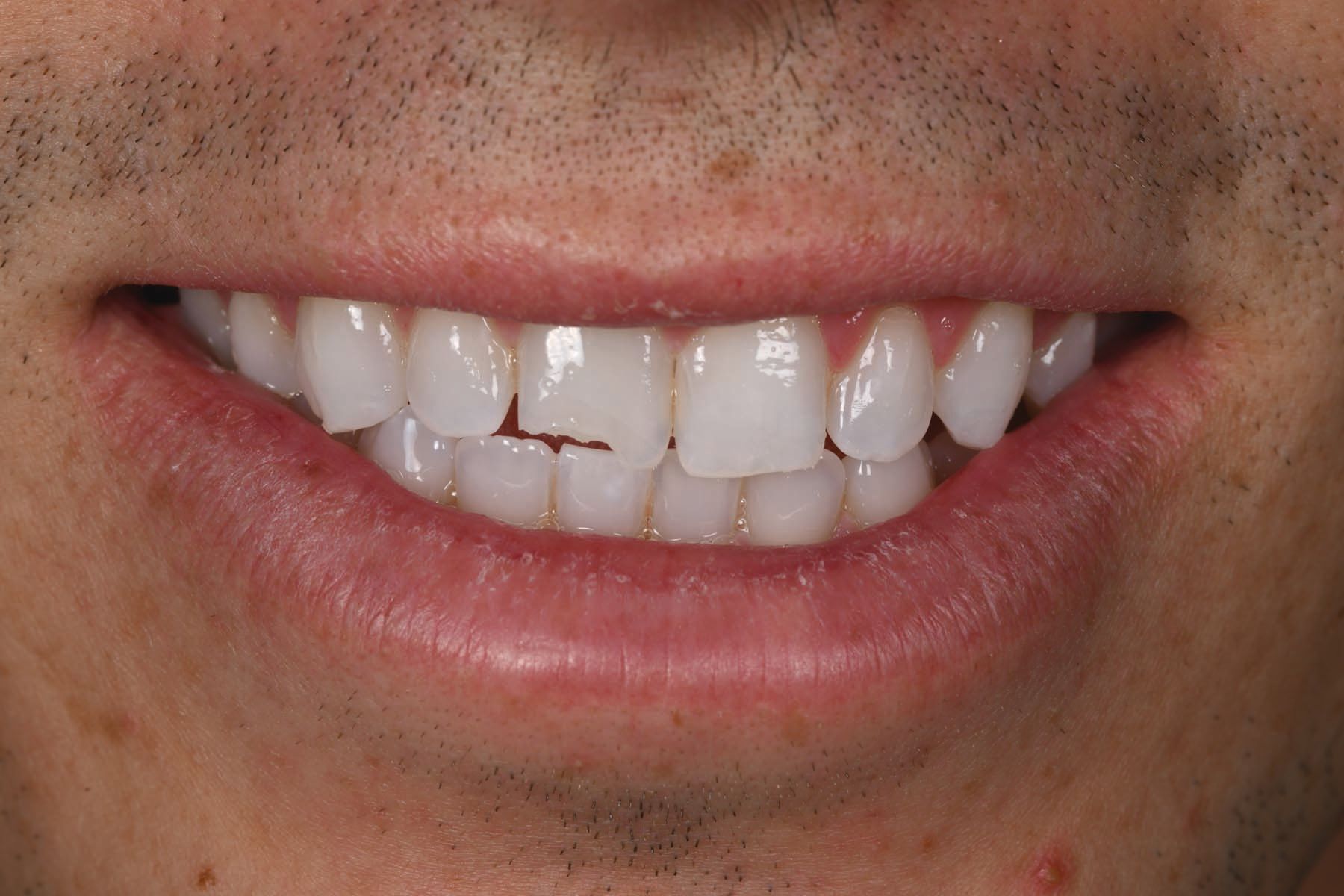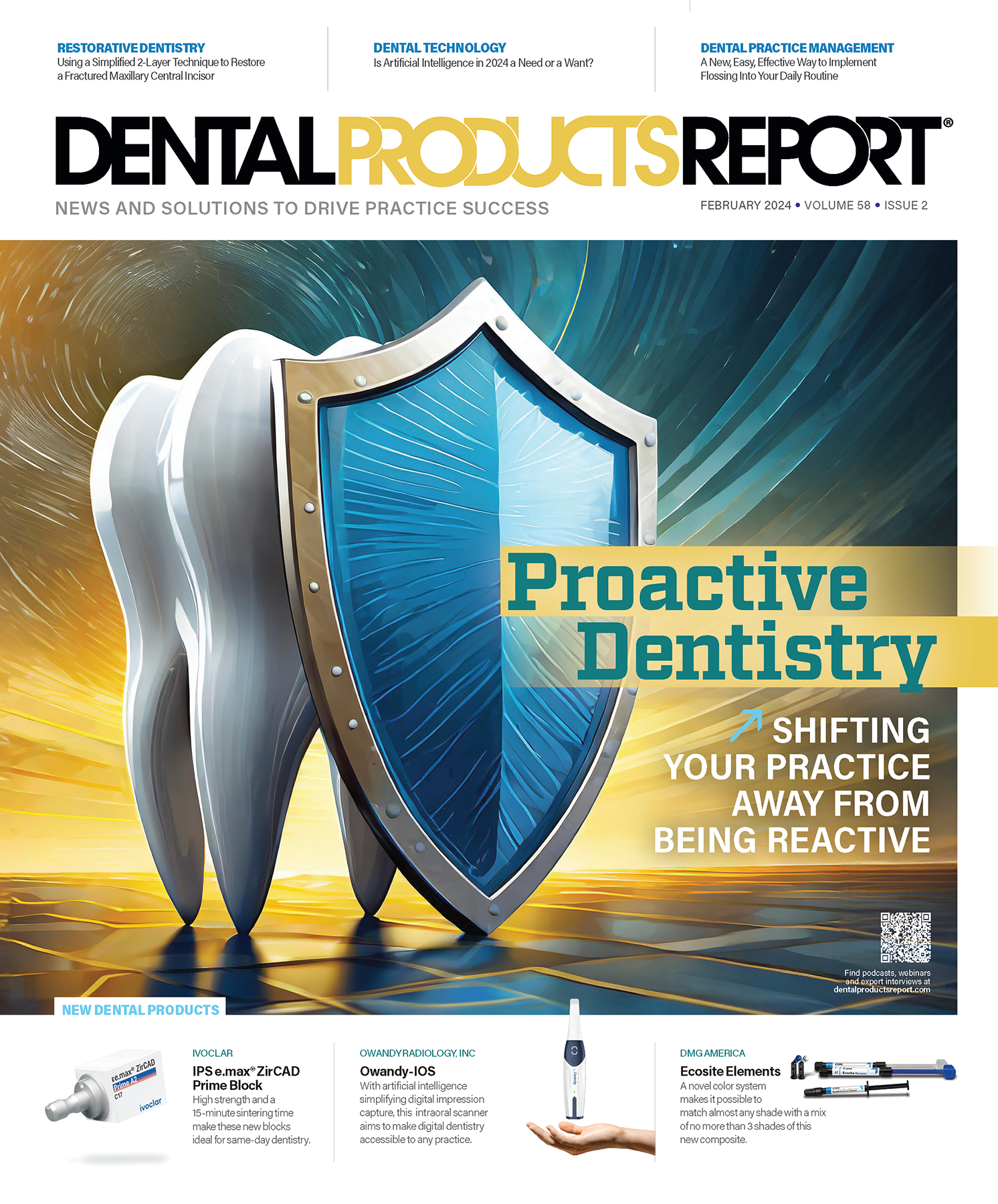Tetric Prime
Tetric® Prime is a universal composite focused on Prime handling. The material has the clinician in mind, responding to requests for a universal composite that offers smooth, creamy handling for flawless adaptation and contouring in the anterior and posterior. There are 12 streamlined shades to create esthetically optimized restorations, and high radiopacity to visualize marginal integrity and ensure proper diagnosis in future recalls.
Ivoclar
800-533-6825
ivoclar.com
Using a Simplified 2-Layer Technique to Restore a Fractured Maxillary Central Incisor
A variety of products from Ivoclar can help patients receive efficient, same-day procedures that save tooth structure, are cost-effective, and deliver great esthetics.
Using a Simplified 2-Layer Technique to Restore a Fractured Maxillary Central Incisor | Image Credit: © Ivoclar

Recreating the natural perfection and nuances of the human tooth in the esthetic zone using direct composite resin restorative techniques can be challenging, especially if that tooth is a single central incisor. With minimally invasive dentistry guiding restorative care and patients demanding efficient yet highly esthetic, natural-looking treatment outcomes, direct composite restorative dentistry has taken on increased importance as a viable treatment modality. The ability to restore an anterior tooth chairside offers practitioners the opportunity to present patients with a restorative solution that is more cost-effective and efficient than all-ceramic indirect options.
Fortunately, advancements and refinements in material and adhesive science have created direct composite material systems that minimize the loss of healthy tooth structure while maximizing the esthetic result. Today’s direct composite resin formulations offer better handling properties, a wide selection of shades, and a streamlined restorative process that reduces the number of incremental layers needed to achieve a highly esthetic, long-lasting outcome that blends seamlessly with adjacent dentition.

In the case presented here, a young, healthy male patient experienced a fractured maxillary central incisor (Figure 1) that was successfully restored using a 2-layer composite protocol developed to minimize chair time, simplify clinical protocols, and ensure a predictable, highly esthetic outcome.
Case Study/Steps
For young adults, the permanent teeth most commonly affected by a traumatic event are the maxillary central incisors.1 The patient in this case presented to the practice with an enamel-dentin fracture on tooth #8 that he wanted permanently restored to its natural shape and shade using the most timely, efficient method possible. The only plausible restorative treatment for an emergency case such as this was to restore the tooth using direct composite dentistry.2-5
The patient’s lips were retracted (OptraGate; Ivoclar) and tooth #8 isolated. To provide the patient with a preview of the expected shape outcome and create a guide for composite layering, a composite material that most closely matched the shade of the patient’s fractured tooth (Tetric Prime A1; Ivoclar) was used to sculpt the desired length and shape of the tooth freehand (Figures 2 and 3) and then fabricate a silicone matrix (Template Ultra Quick Matrix Material; Clinician’s Choice) (Figure 4) as a template to guide composite layering and help with color analysis.
Once set, the matrix was removed as well as the freehand composite material. The tooth was cleaned and air abraded (MicroEtcher II; Danville Engineering) on the facial lower half and along the fractured edges as well as the lingual surface of the tooth to increase the bond strength of the composite resin to the enamel (Figures 5 and 6).
The tooth was isolated with Mylar strips and a 35% phosphoric acid etchant (Ultra-Etch Etchant; Ultradent) applied to the air-abraded dentin and enamel surfaces of the tooth (Figure 7), then rinsed and lightly air-dried. Next, a bonding agent (All-Bond Universal; BISCO) was applied to the air-abraded surfaces (Figure 8) and the matrix filled with the first layer of composite (Tetric Prime B1; Ivoclar) was compressed into place to create adaptation while recreating the lingual aspect of the tooth (Figures 9 and 10).
Next, extruded excess composite on the facial surface was carefully shaped and sculpted using a nonstick anterior composite instrument (IPCL; Cosmedent) (Figure 11). Subtle undulations along the incisal edge were created with a composite tool (P.K. Thomas #3; HuFriedyGroup) to mimic those of a natural tooth and the composite layer light cured (VALO X; Ultradent). The second and final layer of composite (Tetric Prime Bleach L; Ivoclar) was carefully placed, extending from the incisal edge up onto the healthy enamel (Figures 12 and 13).
A thin layer of a low-viscosity unfilled resin wetting agent (ResinBlend LB; Clinician’s Choice) was then applied (Dental Composite Brush #3; Cosmedent) to manipulate, thin, blend, and smooth the composite to its final shape and length (Figure 14) and then light cured. The last step was to finish and polish the restoration (Figures 15 and 16) with OptraGloss (Ivoclar) and (Figure 17) Anterior Direct Composite (Micerium).
The result looked excellent, and the patient was pleased with the esthetics (Figure 18).
Conclusion
Restoring a single central can be one of the most challenging and difficult procedures in dentistry.6 The ability to restore a fractured single central incisor to its natural shape and color in a simplified and predictable 2-step direct composite process opens the door of opportunity for general dentists challenged by the once highly technique sensitive and laborious multilayer protocols. Today’s patient values efficient, same-day procedures that save tooth structure, are cost-effective, and produce highly esthetic and natural-looking results.
References
1. Lam R. Epidemiology and outcomes of traumatic dental injuries: a review of the literature. Aust Dent J. 2016;61(suppl 1):4-20. doi:10.1111/adj.12395
2. Apponi R, Murri Dello Diago A, Colombini V, Melis G. Direct versus indirect techniques to manageuncomplicated crown fractures of anterior teeth following dentoalveolar trauma. Dent J (Basel). 2021;9(2):13. doi:10.3390/dj9020013
3. Lambert DL. Conservative aesthetic Solutions for the adolescent and young adult utilizing composite resins. Dent Clin North Am. 2006;50(1):87-118, vi-vii. doi:10.1016/j.cden.2005.09.007
4. Winter R. Direct vs. indirect restorations for a maxillary central incisor. Spear Digest. November 20, 2019. Accessed Oct. 9, 2023. https://www.speareducation.com/spear-review/2019/11/direct-vs-indirect-restorations-for-a-maxillary-central-incisor
5. Hatkar P. Preserving natural tooth structure with composite resin. J Cosmetic Dent. 2010;26(3):26-34.
6. Tempel RA. The esthetic challenge of treating a single central incisor. J Cosmetic Dent. 2018;34(3):12-18.
